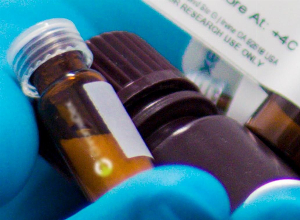What is biologic therapy? A special look at asthma
Published Jan 20, 2020 • By Camille Dauvergne
In some cases, asthmatic patients may be prescribed a biologic therapy: what patients may benefit? How does it work? What are the potential side effects? Read our guide to learn more about these innovative treatments.

Asthma and biologic therapies
Asthma is a chronic respiratory pathology, that can grow progressively more severe. There are two types:
- Atopic asthma, provoked by allergies, it is the most common form and generally begins in childhood or adolescence.
- Intrinsic asthma, non-allergic, it generally manifests later in life.
Beginning in the last few years, biologic therapies have been developed for the treatment of asthma; this is especially the case for atopic asthma. These new treatments target the molecules responsible for an inflammatory reaction, which along with bronchial spasms (narrowing of the bronchial tubes) is one of the main features of an asthma attack. Biologic therapies are not necessary for every asthma patient and are not prescribed until the patient has been thoroughly evaluated.
How do they work?
The biologic therapies used to treat asthma are composed of monoclonal antibodies which target the molecules responsible for an allergic reaction such as IgE (Immunoglobulin E), cytokines or sometimes chemokines. By blocking these molecules, they prevent the activation of pro-inflammation cells and the ensuing allergic and inflammatory reaction observed during an asthma attack.
What is the role of biologic therapies in asthma treatment?
In the case of respiratory pathologies such as asthma, biologic therapies play a rather limited role, in comparison to other domains like hematology or rheumatology. They're only recommended after three or four other treatments have failed to be effective and for patients suffering from severe allergic asthma, that is after a patient has thoroughly tested bronchodilator inhalers (Beta-adrenergic agonists et anticholinergic agents) and corticotherapy inhalers or tablets.
Several other conditions must be present to make a patient eligible for biologic therapy, including:
- Asthma that is poorly controlled despite the patient using high-dosage corticotherapy inhalers (above or equal to 1500 µg a day) or taking corticotherapy orally;
- Symptoms growing consistently worse ;
- The presence of a bronchial obstruction less than or to equal to 60% of theoretical FVC;
- The presence of a total IgE rate of between 30 and 700 UI/mL
Biologic therapies may only be subscribed to adults and children over the age of 12.
What biologic therapies are available for asthma treatment?
There are variety of biologic therapies with each one targeting a different molecule:
- OMALIZUMAB (Xolair) an anti-IgE antibody
- MEPOLIZUMAB (Nucala) an anti-IL-5 (interleukin 5) antibody
- BENRALIZUMAB an anti-IL-5Rα antibody
- Anti-IL-3 antibodies
- DUPILUMAB an anti-IL-4R antibody
- ENBREL an anti-TNFα (a pro-inflammatory cytokine)
OMALIZUMAB and MEPOLIZUMAB are for the moment the only biologic therapies approved for asthma treatment, the others are still in the clinical trial stage.
How is Omalizumab taken?
The posology is determined by the patient's IgE serum levels and weight and varies by individual. It is administered under the skin by injection every 4 months. If the prescribed dose is greater than 300 mg (2 ampoules), it's broken up into 2 injections 15 days apart.
Is it effective?
Omalizumab has been shown to very effective in preventing an immediate response and a delayed bronchial response after exposure to an antigen (the triggering agent). It makes a better symptomological score possible as well as improved patient quality of life and a 50% reduction of the most severe exacerbations. It is indisputably a huge leap forward in the treatment of severe cortico-dependant allergic asthma.
What are its side effects?
Side effects are limited to soreness around the injection site and some urticarial reactions. The solutions may prove difficult to administer as the antibody is not easily dissolved and must be put through a magnetic stirrer for between 20 and 30 minutes.
If the patient shows no improvement after 4 months on a biologic therapy, the treatment is halted. Prolonging the treatment for more than 12 months or longer if beneficial effects are shown needs further study to prove that it's safe.
Warning, this article is meant as a general overview and in not meant to replace advice from a medical professional. It does not address all the potential variations that may occur from patient to patient. Every patient is different and should consult with their physician before modifying their medical treatment!
Article written by Camille Dauvergne, 4th year pharmacy student, reviewed by Louise Bollecker, Carenity Content Manager.

 Facebook
Facebook Twitter
Twitter


